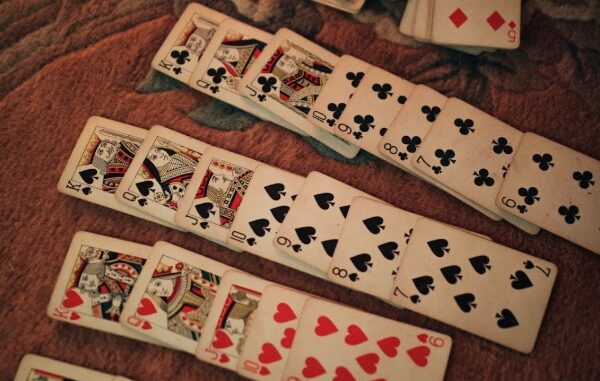
Fancy a game of cards, but don’t have anyone to play with? From klondike solitaire to poker squares, there are a range of card games that you can play by yourself. Such games can be a great test of strategic planning, patience and probability calculation. Here are 7 examples that are worth trying.
Klondike
Klondike is the most recognised form of solitaire. In fact, it’s sometimes simply referred to as ‘solitaire’ (despite there being many other variants – which are listed below). To play Klondike, arrange the cards into 7 tableau piles (this guide to playing Klondike details how to arrange the tableau piles) and one stockpile. The aim of the game is to build four foundation piles for each suit in ascending order from Ace to King. This is done by moving cards strategically from each of the tableau piles or drawing cards from the stockpile.
Spider
Spider solitaire is slightly more complex than Klondike because it uses two decks of cards. In this game, there are 10 tableau piles and you must sort them into 8 foundation piles. 4 of the tableau piles contain 6 cards, and the other 6 tableau piles all contain 5 cards, with all cards placed face-down except the top card of each tableau pile. Unlike Klondike, the foundation piles in Spider are sorted into descending order from King to Ace and built using alternating colours. Spider solitaire is one of the most popular single-player card games played online.
Pyramid
In this solitaire variant, 28 cards are arranged into the shape of a pyramid (hence the name!). You draw cards from a stockpile and must eliminate cards from the pyramid by pairing cards that total 13 (such as a 10 and a 3). Aces are worth 1, Jacks are worth 11. Queens are worth 12 and Kings are worth 13 (and can be removed from the pyramid without pairing them). Cards must be eliminated starting from the base of the pyramid to the tip.
Beleaguered Castle
Beleaguered Castle is a variant of solitaire that is known for being a bit more challenging. In fact, most games are doomed to fail from the beginning. However, for those who really want to put their strategic planning skills to the test, it can be a rewarding game. The aim is to break down ‘the castle walls’ – which consist of 8 tableau piles. This is done by moving cards onto one of four foundation piles of each suit arranged in ascending order from Ace to King. Unlike other games of solitaire, there is no stockpile that you can draw from – all the cards are already laid out on the tableau face up.
Forty Thieves
Forty Thieves is another challenging solitaire variant that uses two decks of cards. It also goes by the names Big Forty, Napoleon St Helena and Roosevelt at San Juan. This game consists of 10 tableau piles and 8 foundation piles much like Spider Solitaire – however there is a difference. In this game, each of the 10 tableau piles consists only of 4 cards each (which is where the ‘forty’ thieves name comes from) which are arranged face-up. You must sort these into the foundation piles by arranging them by suit in ascending order from Ace to King.
Bowling
This unique and fun version of solitaire is inspired by bowling. Cards are arranged in a 10-card triangular formation similar to the pins in a bowling setup. You then draw ‘bowling ball’ cards with the intention of ‘knocking down’ each of the cards in the triangular formation. Cards are knocked down by pairing them with cards of the same value – or you can knock down multiple pin cards that add up to the value of the bowling ball card (e.g. drawing an 8 allows you to knock down a 5 and a 3). Unlike Pyramid solitaire, cards must be eliminated from the tip of the triangle to the base.
Poker squares
This is a single player version of Poker in which you must create the best five card Poker hand from a grid of cards arranged in a 5×5 square. Each card is dealt one at a time and you must strategically place the card on the grid to try to form Poker hands (e.g. pairs, three of a card and straights) across each row and column. You score points for each successful hand you manage to lay down within the grid once all 25 spaces have been filled. It’s a game that mixes luck and strategy.

Leave a Reply